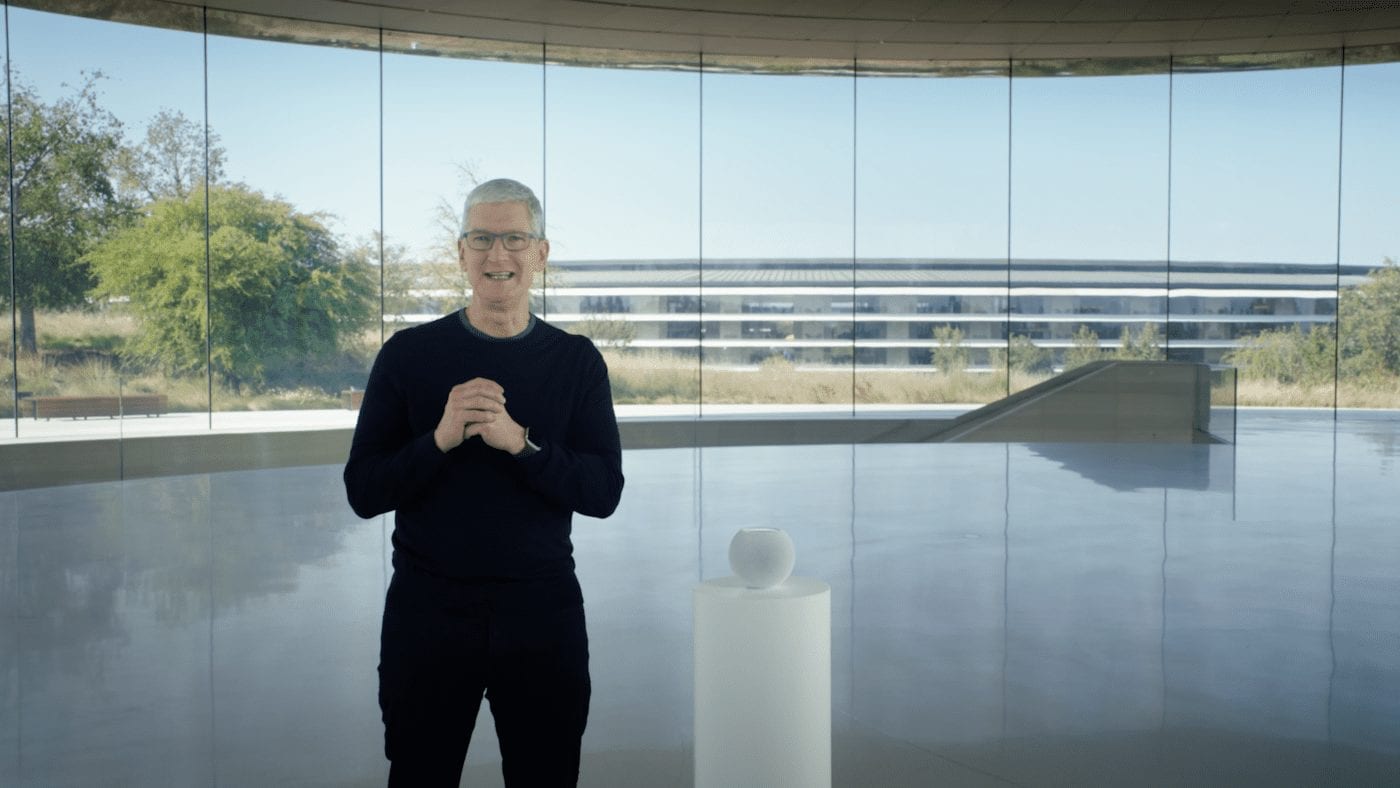
Two months, two Apple events. Last month the world was treated to new Apple services (Apple One and Apple Fitness+), the Apple Watch Series 6 and Apple Watch SE, a next-generation iPad, and an all-new iPad Air. On October 13, the iPhone line received a significant refresh with the 5G-capable iPhone 12 and the HomePod received a smaller companion. Let’s take a look at the announcements and why they’re important.

HomePod mini
Since the original HomePod smart speaker was first shipped in 2018, the common complaints seemed to be that it was too expensive and too big. That all changed with the announcement of the HomePod mini ($99), a smaller version of the HomePod that still provides impressive sound quality, acts as a gateway to the Siri digital assistant, and works to control home automation systems through HomeKit.
The device comes in two colors: space gray and white. Just 3.3 inches high and 3.9 inches wide, the HomePod mini takes up a lot less real estate on table or desk than the full-size unit. It weighs just .76 lbs, and is covered in an acoustically-transparent fabric. If you want to see what a HomePod mini will look like in your home, Apple has provided an AR viewer. Just go to this page on your iPhone or iPad and scroll down to near the bottom, then click the View in AR button.

Intercom
Since at $99 a pop many households may be able to afford more than one HomePod mini, Apple threw a new feature into the mix: Intercom. This feature uses Siri to send voice messages to all or specific HomePods, and can also extend outside the home. Have your iPhone in your CarPlay-equipped car? You can send or receive messages while you’re driving. Even an Apple Watch or pair of AirPods can act as a remote Intercom device.
One feature I thought was quite cool was the touchless handoff. Let’s say you’re listening to a song on your HomePod mini and you’re about to leave the house. Just bring your iPhone near the HomePod mini and the song continues to play on the iPhone.
The HomePod mini is important to the Apple line as it should drastically increase customer acceptance of the product and further establish Siri, Apple Music, HomeKit and other Apple products in the home. Customers will be able to pre-order the HomePod mini on November 6, 2020 and pick them up (or have them delivered) on November 16.
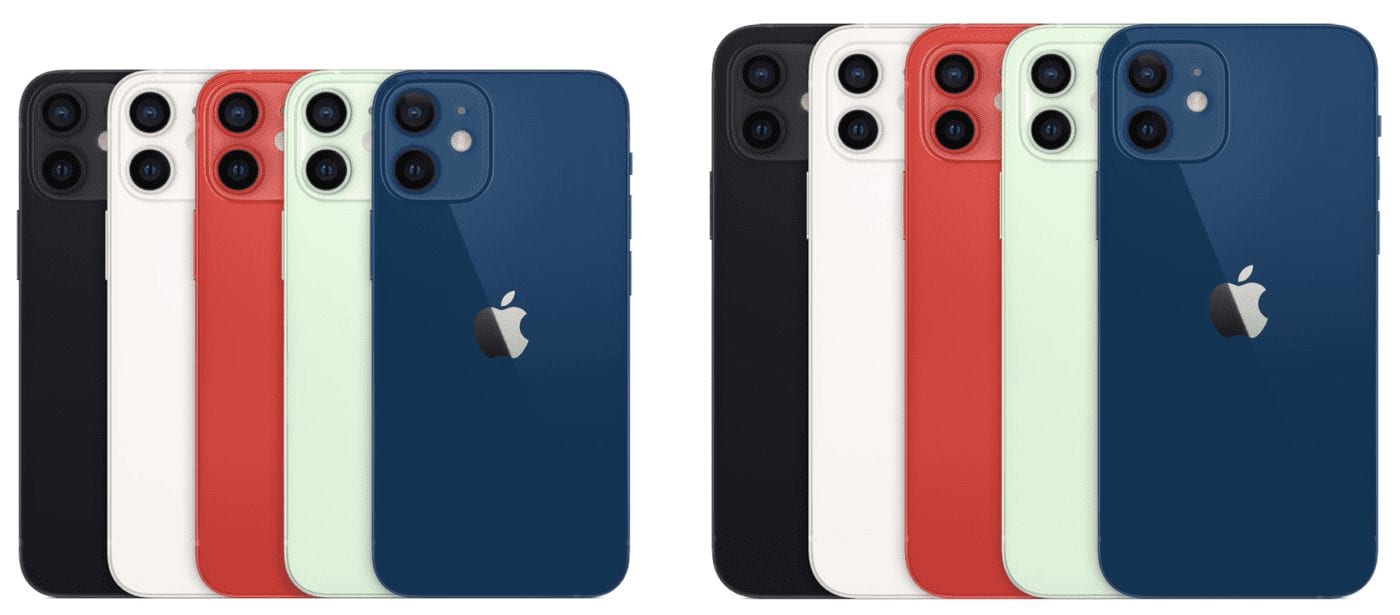
iPhone 12 and iPhone 12 mini
The HomePod wasn’t the only Apple product to get a “mini-me” companion. With the announcement of the 5G-capable iPhone 12 today came the iPhone 12 mini, which Apple is touting as “the world’s smallest, thinnest, lightest 5G phone”. The iPhone 12 mini has a 5.4-inch Super Retina XDR display featuring 2340‑by‑1080-pixel resolution at 476 ppi, is 2.53 x 5.18 inches in size, is just .29 inches thick, and weighs a scant 4.76 ounces. Yep, if you’re tired of super-sizing your iPhones, the iPhone 12 mini will be just perfect for you. It starts at $699 before trade-ins, and will be available for pre-order this Friday (October 16, 2020) at 5 AM PDT.
The iPhone 12 has a 6.1-inch Super Retina XDR display with 2532‑by‑1170-pixel resolution at 460 ppi. It is 2.82 x 5.78 x .29 inches in size, and weighs 5.78 ounces.
The iPhone 12 and iPhone 12 mini both come in a variety of colors in a bold new design: white, black, blue, green, and PRODUCT(RED). The design features aerospace-grade aluminum edges that contain the 5G antennas, the back is a matte-finish glass, and the front of the phone features a new ultra-tough material Apple calls Ceramic Shield. The company says that this provides four times better drop performance – in other words, the screen is four times less likely to shatter than previous iPhones in a drop situation.
The big story is the 5G compatibility…
As expected, the iPhone 12 and iPhone 12 mini (as well as the Pro models we’ll discuss later) come with support for a number of 5G and earlier networks:
- 5G NR (Bands n1, n2, n3, n5, n7, n8, n12, n20, n25, n28, n38, n40, n41, n66, n71, n77, n78, n79)
- 5G NR mmWave (Bands n260, n261)
- FDD‑LTE (Bands 1, 2, 3, 4, 5, 7, 8, 12, 13, 14, 17, 18, 19, 20, 25, 26, 28, 29, 30, 32, 66, 71)
- TD‑LTE (Bands 34, 38, 39, 40, 41, 42, 46, 48)
- CDMA EV‑DO Rev. A (800, 1900 MHz)
- UMTS/HSPA+/DC-HSDPA (850, 900, 1700/2100, 1900, 2100 MHz)
- GSM/EDGE (850, 900, 1800, 1900 MHz)
mmWave
The big news is the mmWave support. This is equivalent to Verizon’s 5G Ultra Wideband, which can support up to 4Gbps download speeds. Most carriers plan to offer similar support, but you’re not going to find it everywhere. mmWave will usually be deployed only in busy downtown regions and at densely-packed venues like sports arenas. Speaking of Verizon, that company took advantage of Apple’s announcements to tout the fact that it “turned on” its Nationwide 5G network (slower speeds than mmWave) today. That network covers more than 200 million Americans.
Two things that you won’t find in the boxes for any of the new iPhones announced today are AC adapters and EarPods. Apple figures that everyone on the planet has at least one of each, so they’ve decided to stop including them.
MagSafe
You will probably want to pay attention to the new MagSafe chargers from Apple, though. Apple built in a new magnetically-aligned charging setup that supports wireless charging up to 15W. MagSafe is also included in new cases and even a snap-on wallet from Apple and a number of third-party vendors.
Powered by the A14 Bionic chip, the iPhone 12 and 12 mini both come with some crazy-powerful cameras…and these don’t even come close to the Pro models. The two cameras on the back are both 12MP, one an Ultra Wide with f/2.4 aperture and 120° field of view, and the other a Wide with a fast f/1.6 aperture. The two cameras combine for up to 2x optical zoom. Night mode is supported on both cameras, as well as Deep Fusion.
HDR video
For video, the two phones can do HDR video recording with Dolby Vision up to 30 frames per second and 4K video at 24 fps, 30 fps or 60 fps. Slo-mo is supported at 1080p resolution at 120 or 240 fps, and there’s a new Night Mode Time-Lapse made possible by improved sensors and lenses.
Pricing and availability? The iPhone 12 can be pre-ordered on October 16 for deliveries starting October 23, while the iPhone 12 mini can be pre-ordered on November 6 for deliveries starting on November 13. Storage capacities start at 64GB, with 128 and 256GB models available. The pricing of the iPhone 12 starts at $799, with the iPhone 12 mini at $699.
So, what are the big selling points with the new iPhones?
Unprecedented power, 5G compatibility, faster charging with MagSafe, and better durability with the Ceramic Shield displays. Personally, I think the iPhone 12 mini is going to be very popular with those who are getting tired of hauling what amounts to a small tablet in their pockets. It provides a tremendous feature set and fast performance in a very small package that doesn’t require a folding screen.

iPhone 12 Pro and iPhone 12 Pro Max
And now to the really BIG news, the Pro series iPhone 12s. While the iPhone 12 mini has shrunken the power of the A14 Bionic and speed of 5G to a tiny form factor, the iPhone 12 Pro Max reaches the largest screen size we’ve seen yet on an iPhone. It’s a whopping 6.7-inch diagonal Super Retina XDR display in a package that is slightly bigger than the iPhone 11 Pro Max (which features a 6.4-inch display). The iPhone 12 Pro display measures 6.1 inches diagonally, once again in a slightly larger case than its iPhone 11 sibling with its 5.8-inch display. The following image from Apple shows the relative sizes of the iPhone 12 and 11 Pro models:
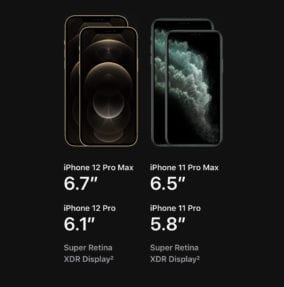
The iPhone 12 Pro Max boasts the largest number of pixels ever in an iPhone — over 3.4 million, with 1200 nits brightness for HDR photos and movies and a 2 million to 1 contrast ratio.
This has to be the toughest iPhone yet, as the sides are made of surgical grade stainless steel in gold, silver, graphite, and the new Pacific Blue. As with the smaller iPhone models, the Pro models use Ceramic Shield for the front display and a matte glass back. The iPhone Pro models feature IP68 water resistance, meaning that they can withstand being held under 6 meters (about 20 feet) of water for up to 30 minutes.
The differences…

The main differentiators between “regular” and Pro iPhones are the cameras, as well as the photographic and video capabilities. The iPhone 12 Pro and Pro Max are both equipped with four cameras – three in the back, one in the front. To improve autofocus in low-light conditions as well as power AR applications, there’s a built-in LiDAR scanner in the camera cluster on the back of the phones. That LiDAR scanner adds an important capability for photographers – the ability to do Night Mode portraits (see image at right).
Apple says that “iPhone 12 Pro models are the first cameras and only devices in the world to enable an end-to-end experience for HDR video with Dolby Vision,” meaning that the iPhone 12 Pro and Pro Max can shoot, edit, and deliver video that supports both High Dynamic Range and wide color gamut. This is all enabled by the powerful A14 Bionic SoC, and the improved cameras.
Lenses
Both the Pro and Pro Max use a new seven-element lens Wide camera with an ƒ/1.6 aperture – the fastest lens used on an iPhone. That translates to a 27 percent improvement in low-light performance in both photo and video for the iPhone 12 Pro. The Pro Max adds a 47 percent larger sensor with 1.7-micrometer pixels that cranks that low-light performance up by 87 percent.
The Ultra-Wide camera is the same on both Pro units, featuring a 120-degree field of view. The Telephoto lenses vary between the two models – the iPhone 12 Pro uses a 52 mm focal length camera that brings optical zoom range up to 4x, while the Pro Max uses a 65 mm focal length that produces a 5x optical zoom range.
Of course, the Pro and Pro Max both have optical image stabilization, but the Pro Max does something different – rather than moving the lens as in other systems, it actually moves the image sensor in the x and y axes. This is called “sensor-shift optical image stabilization” and was previously only found in high-end cameras.
ProRAW
The Pro models will both support Apple’s upcoming (this fall) ProRAW, a new RAW format that Apple says “combines Apple’s multiframe image processing and computational photography with the versatility of a RAW format. Users can experience full creative control over color, detail, and dynamic range natively on iPhone or with other professional photo editing apps.”
In the DSLR and mirrorless camera world, there are a variety of RAW formats that have been created by the camera manufacturers. It usually takes a while for editing apps to support new RAW formats, so those who like to shoot in the minimally-processed format might have to wait a few months for their favorite photo editing apps to handle ProRAW.
When can you get your hands on an iPhone 12 Pro or Pro Max? Pre-orders for iPhone 12 Pro begin Friday, October 16, with availability beginning Friday, October 23. iPhone 12 Pro Max will be available for pre-order Friday, November 6, and in stores beginning Friday, November 13.

Why are the iPhone 12 Pro and Pro Max important to Apple? Some photographers and videographers are beginning to use Apple’s Pro smartphones as “daily carry” cameras for taking high-quality “proof” images and even for final product. The improved cameras in the Pro series still don’t have the focal length range of a good set of interchangeable lenses on a pro-level digital camera, but for a lot of work the 5x optical zoom of the iPhone 12 Pro Max is acceptable.
Some purists may scoff at the “measly” 12MP camera, but Apple has shown that pixel count isn’t everything. Through its industry-leading advances in computational photography, each generation of iPhone Pro has created more converts who see that their 12MP iPhone Pro images put those from expensive and bulky digital cameras to shame. I’m one of those – during a recent trip, I reached for my iPhone 11 Pro Max much more often than I grabbed the Canon EOS RP mirrorless with its 26.2MP sensor.
The “Hi, Speed” event on October 13, 2020, wasn’t the longest or most exciting event we’ve seen over the years, and the long-anticipated AirTags accessories still didn’t show up. However, the improvements across the entire iPhone 12 line – from mini to Pro Max – are solid and the phones should be hot sellers. The rather sedate sales of the HomePod should heat up with the new HomePod mini, and finally give Amazon’s Alexa smart speakers a run for their money.
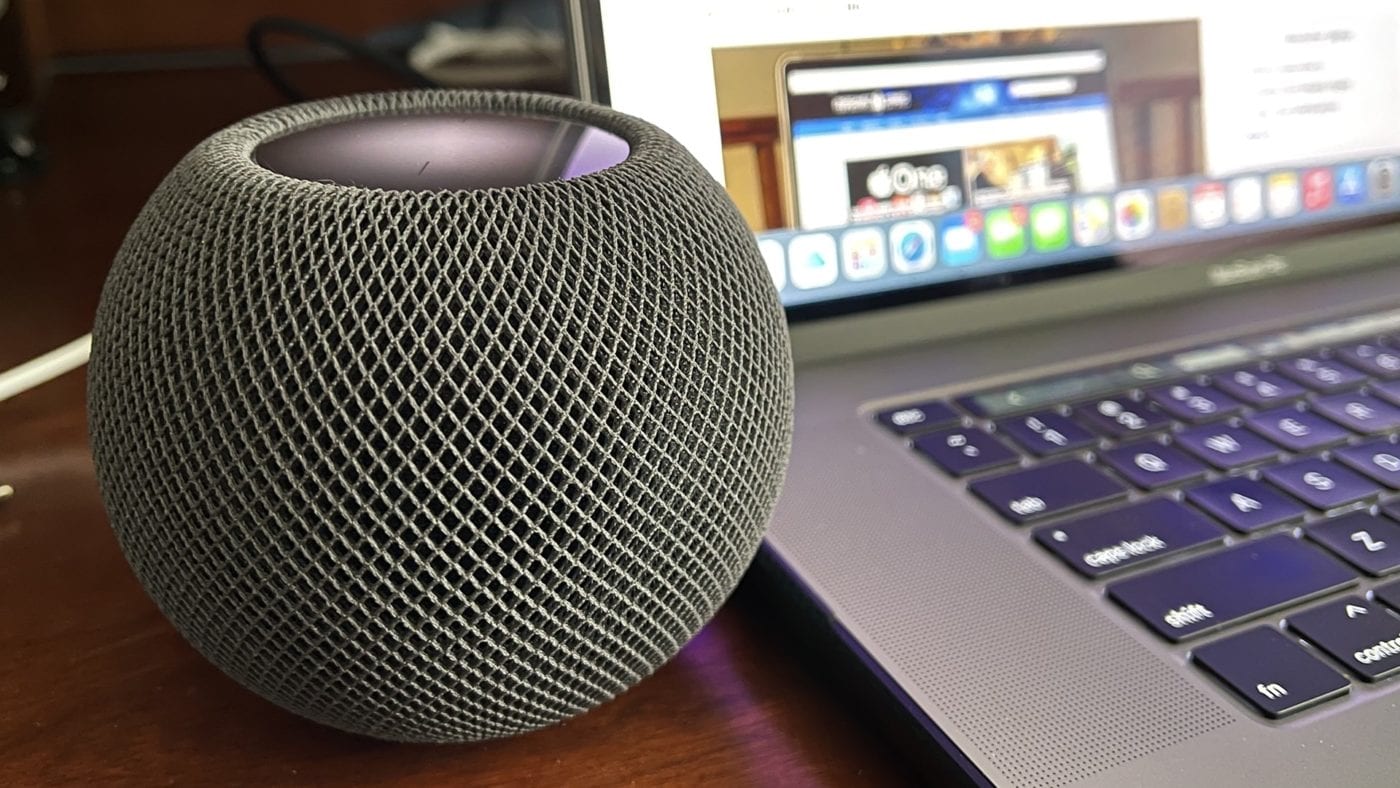


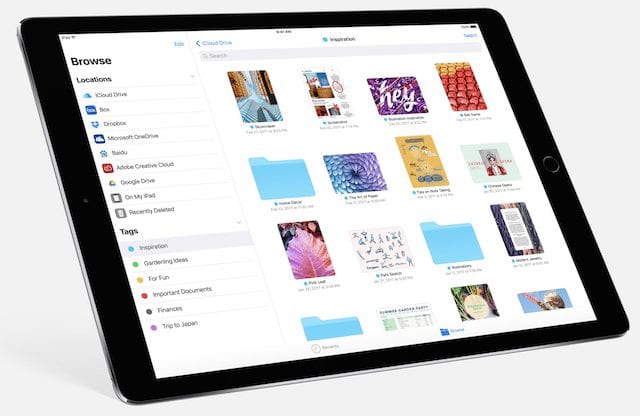
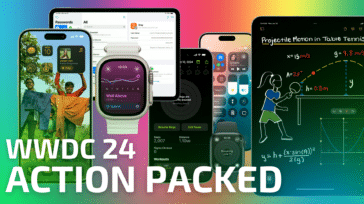
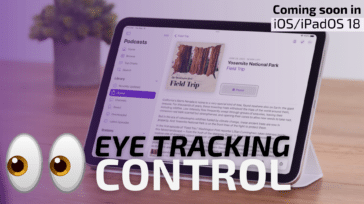




iPhone 12 Pro Max. Gotta have those cameras.
5G has always impressed me as a solution in search of a problem.
Long wave is marginally better than LTE advanced, and mm wave is (in my view) a way for Qualcomm to sell more modems, carriers to sell expensive plans, and handset makers to profit from handset churn.
It’s hard to imagine mm wave to sustaining a signal in a moving device – with signal being blocked by the user’s body, buildings, signs, trees, leaves, and weather – and the modem constantly retraining to differing protocols makes me wonder how much that extra speed is going to count.
For stationary users, walls and most windows will block the signal so 5G is pretty much a no-go inside unless you have 5G repeaters – so it’s principal use will be high density city-centers, convention centers, and stadiums.
OTOH, these expensive Qualcomm modems will be faster than their Intel counterparts, and they claim LTE advanced will now feature up to 2 gbps – though as always YMMV.
At least on the telecom side, these new iPhones will pretty much be future-proofed with 5G and Wifi 6.
The 12 mini is not too much larger than my original SE.
8 mm taller, 5 mm wider & 0.5 mm thinner.
And 35 mm larger screen size!
4 years my beloved SE has lasted me, now i see an upgrade in my future :)
Actually, the iPhone 12 and iPhone 12 mini is $799 and $699 if you are a customer of AT&T or Verizon.
If you want to buy it unlocked or you’re a T-Mobile customer, it is $829 and $729.
This smells badly of collusion with the AT&T/Verizon duopoly.